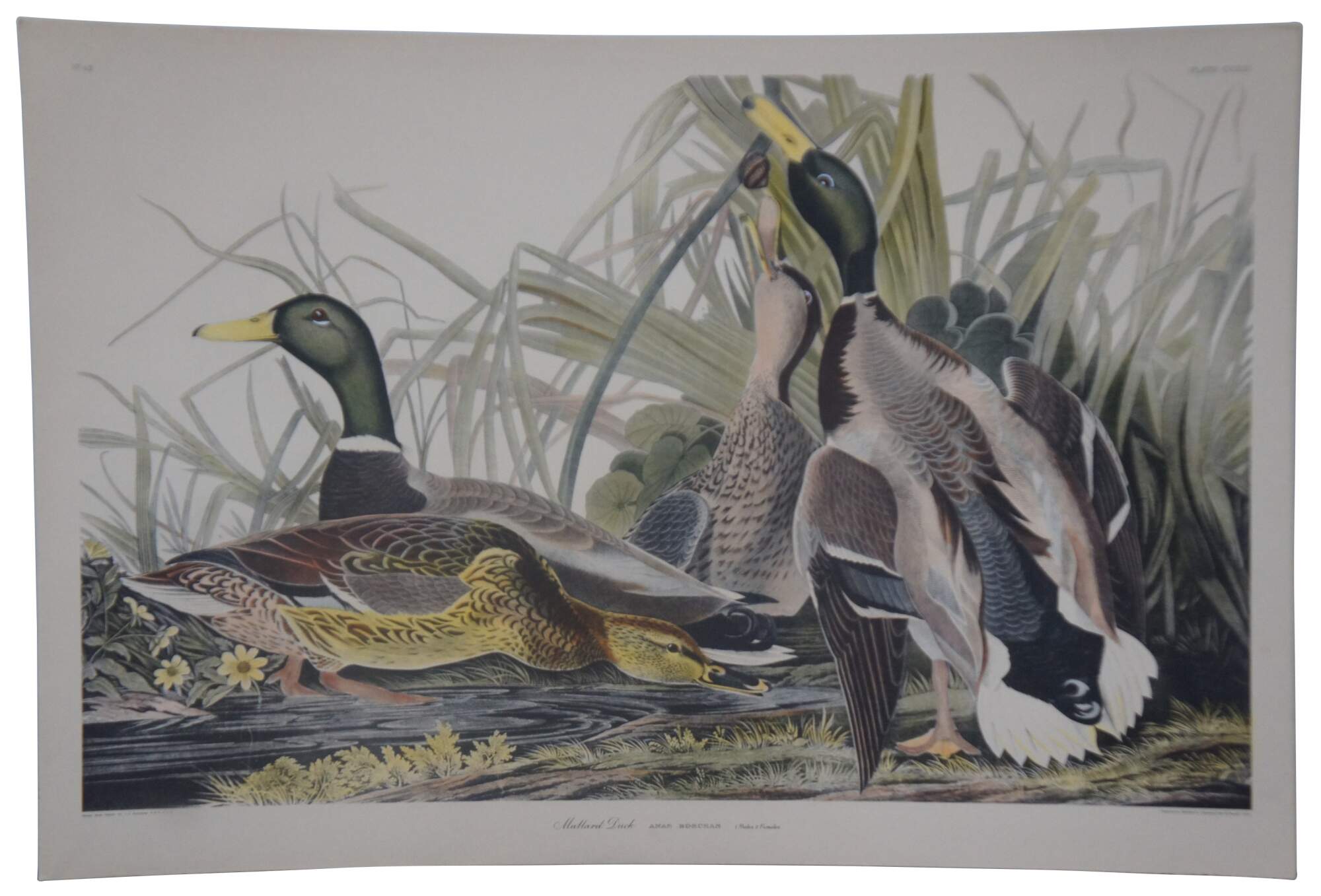
Shipping:
Free Shipping Included
Delivery:
Estimated 2-15 Business Days
Payments:
Credit Card, Check, Cash, PayPal, Apple Pay, Venmo
Returns:
30 Days 100% Money Back Guarantee, Buyer Pays Return Shipping
Description
20th century Robert Havell colored engraving featuring two pairs of Mallard Ducks drawn by J.J Audubon. “Born in Reading, England, Robert Havell (1793-1878) was the son of an engraver, and was expected to follow that profession. Fulfilling his destiny, he is remembered for his aquatint engraving of all but the first 10 plates of John James Audubon's Birds of America. He first visited Audubon in 1839 in New York City and traveled and sketched the countryside in a homemade horse-drawn trailer, and together they had skills that were well met. He also did artwork in oil and watercolor in Hudson River style with Luminism. However, he preferred to think of himself as an engraver.
Until 1841, he lived in Brooklyn and in 1842 his travel-weary wife established a house for the family in Ossining (Sing Sing) on the Hudson River, and he later, 1857, moved to Tarrytown, living there to his death in 1878. During this time he did landscape painting that in style and subject matter fit the criteria for being Hudson River School painting. Among his titles were several titled View of the Hudson River, as well as Sunset Near Sing-Sing and Fauns Leap, NY.
Havell traveled frequently, sketching and taking notes and then doing studio landscapes in oil and watercolor as well as making engravings, the later which remained his favorite medium. His engraving, West Point from Fort Putnam, received much public attention, and he also did engravings of American cities.” “John James Audubon (1785-1851) is best known for his ornithological magnum opus, The Birds of America; from Original Drawings. Published between 1827-38 in an edition of around 200, The Birds of America represents the culmination of Audubon's life work as a naturalist-artist, depicting in 435 plates every bird species from North America. In order to feature the birds as life-size, Audubon insisted that the engravings were printed on """"double-elephant"""" broadsheets measuring 39 ½ x 26 ½"""", about twice the size of the drawing paper on which he made the original watercolor studies.
Audubon's path to becoming the world's greatest bird painter was circuitous, if not serendipitous. Born in 1785 in Les Cayes, Santo Domingo, the illegitimate son of a French sea captain and his Creole mistress, Jean-Jacques Fougère Audubon grew up in Nantes, France. It was here that he developed his passion for birds, collecting countryside specimens that he would stuff, display, and illustrate. To prevent his son's conscription in the Napoleonic Wars, Jean Audubon sent him in 1803 to a farm he had recently purchased outside of Philadelphia, where young Audubon (having anglicized his name to John James) preferred collecting birds to running the family's mining business. Five years later, Audubon and his Pennsylvania bride, Lucy Bakewell, settled in Kentucky, and he cobbled together jobs as a merchant, miller, and portrait painter. All some time, he feverishly studied and rendered birds, creating a system of suspending specimens from wires as a means of simulating lifelike poses. His discovery of new bird species on trips during the early 1820s through Mississippi, Louisiana, Alabama, and Florida convinced him to compile an illustrated book of native birds, despite his flimsy fortune and Lucy's hardship as the family breadwinner.
Unable to find a publisher in Philadelphia for his proposed book of bird drawings, Audubon traveled to England and Scotland in 1826 in search of support. Abroad, he met luminaries in the scientific community, including the botanist William Roscoe, who helped him exhibit his drawings in Manchester; the ornithologist William Swainson; the naturalist William MacGillivray, who later edited the text for The Birds of America; and William Home Lizars, an engraver in Edinburgh who, impressed by Audubon's work, agreed to print the massive folio. However, when Lizars was only able to complete the first ten plates, Audubon approached the established London engraver Robert Havell, who together with his son Robert, Jr., took up the project. Ultimately, The Birds of America was issued serially in five-plate sets, for a total of 435 plates, over the course of a decade.”
Condition
Good Overall - Gentle wear
Dimensions
36” x 24” (Width x Height)